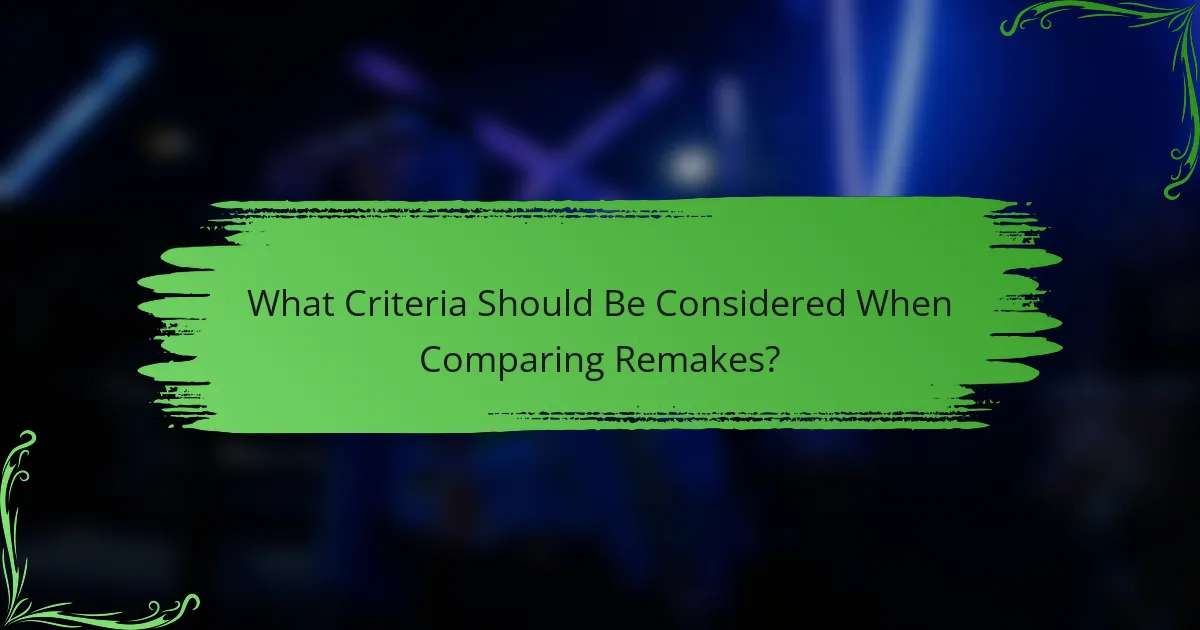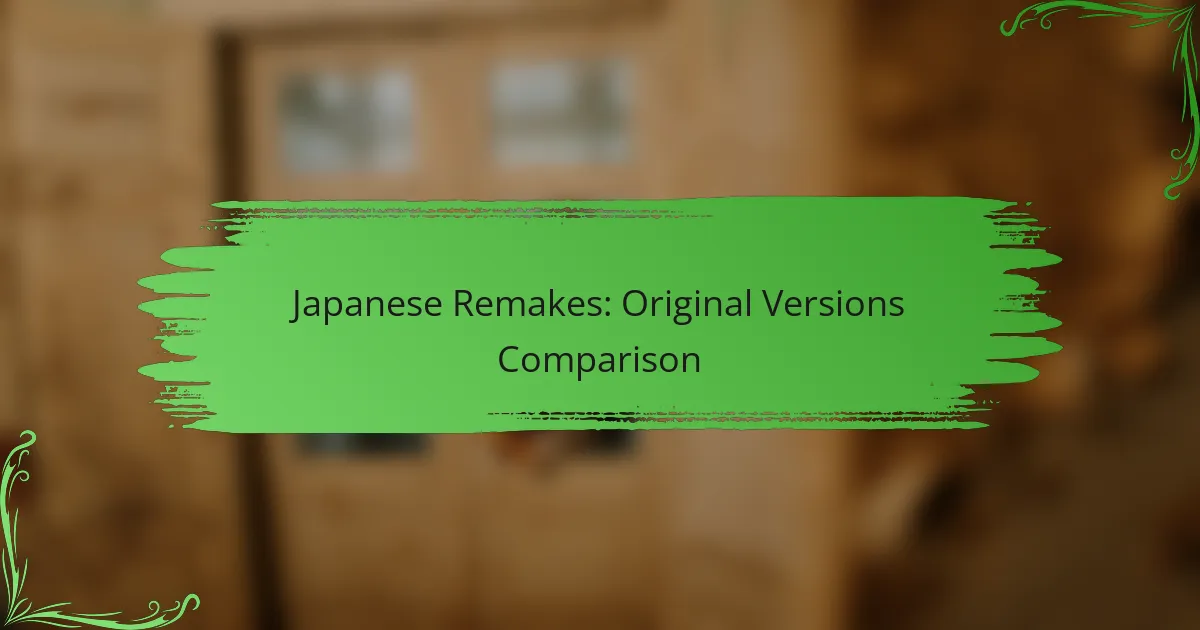Japanese remakes frequently present a fresh take on original narratives, showcasing variations in storyline, character development, and cultural context. These adaptations often resonate with audiences, particularly in the U.S., where films like “Ringu” and “Oldboy” have sparked interest and debate regarding their differences from the originals. By reinterpreting familiar tales, these remakes can enhance relatability for local viewers while also challenging the expectations of fans of the original works.

What Are the Key Differences Between Japanese Remakes and Original Versions?
Japanese remakes often differ from their original versions in terms of storyline, character development, cultural context, visual style, and soundtrack. These differences can significantly impact the overall experience and reception of the remake compared to the original.
Storyline Variations
Storyline variations in Japanese remakes can range from minor tweaks to major overhauls. For instance, a remake might shift the setting to a different time period or alter key plot points to enhance dramatic tension. This can lead to a fresh perspective on familiar narratives, making them resonate differently with audiences.
Examples include changes in character motivations or the introduction of new subplots that reflect contemporary issues. Such variations can appeal to both new viewers and fans of the original, offering a blend of nostalgia and innovation.
Character Development Changes
Character development in Japanese remakes often sees a deeper exploration of protagonists and antagonists. Remakes may flesh out backstories or introduce new characters that provide additional context or conflict. This can create a richer emotional landscape that engages viewers more effectively.
For example, a character who was a secondary figure in the original might take on a more prominent role in the remake, allowing for a more nuanced portrayal of their journey. This shift can enhance audience connection and investment in the storyline.
Cultural Adaptations
Cultural adaptations are crucial in making Japanese remakes relatable to local audiences. This can involve altering dialogue, references, or even character behaviors to align with cultural norms and values. Such changes help the story resonate more deeply with viewers who may have different cultural backgrounds.
For instance, humor that works in one culture may not translate well, prompting remakes to adjust comedic elements to suit local tastes. These adaptations ensure that the essence of the story remains intact while making it accessible to a broader audience.
Visual Style Differences
Visual style differences in Japanese remakes can significantly impact the viewing experience. Remakes often employ updated cinematography techniques, special effects, and production design to create a more visually appealing product. This can include modernizing settings or enhancing action sequences to match current audience expectations.
For example, a remake might use advanced CGI to depict scenes that were originally done with practical effects, resulting in a more immersive experience. Such visual enhancements can attract both fans of the original and new viewers looking for high-quality production values.
Soundtrack Modifications
Soundtrack modifications in Japanese remakes can play a pivotal role in setting the tone and enhancing emotional impact. Remakes may feature new compositions or reimagined versions of the original score to better align with the updated narrative or visual style. This can create a fresh auditory experience that complements the story.
For instance, a remake might incorporate contemporary music trends or collaborate with popular artists to appeal to a younger audience. These changes can elevate the overall atmosphere and make the remake feel more relevant to current viewers.

Which Japanese Remakes Have Gained Popularity in the US?
Several Japanese remakes have found significant popularity in the US, often due to their unique storytelling and cultural elements. Films like “Ringu” and “Oldboy” have not only captivated audiences but also sparked discussions about the differences between the original and the remake.
Ringu vs. The Ring
“Ringu,” directed by Hideo Nakata, is a horror film that introduced American audiences to the concept of cursed videotapes. The US remake, “The Ring,” directed by Gore Verbinski, retained the core premise but adapted it to fit Western sensibilities, enhancing the visual effects and narrative pacing.
Key differences include character development and cultural references, which were modified to resonate with American viewers. While “Ringu” relies heavily on psychological horror, “The Ring” incorporates more jump scares and a faster plot progression.
Shutter Island vs. Shutter
“Shutter,” a Japanese film directed by Masayuki Ochiai, revolves around a couple who experiences supernatural occurrences after a tragic accident. The American adaptation, “Shutter Island,” directed by Martin Scorsese, shifts the focus to a psychological thriller set in a mental institution, diverging significantly from the original’s ghost story elements.
The remake emphasizes themes of trauma and guilt, while the original leans more towards the horror of the unknown. Both films explore the human psyche, but their approaches and settings create distinct viewing experiences.
Oldboy vs. Oldboy
The original “Oldboy,” directed by Park Chan-wook, is a South Korean film that gained international acclaim for its intense narrative and shocking twists. The American remake, also titled “Oldboy,” directed by Spike Lee, attempts to capture the essence of the original while incorporating a different cultural context and storyline changes.
While both films share a central theme of revenge, the American version alters key plot points and character motivations, which has led to mixed reviews. Fans of the original often debate whether the remake does justice to its predecessor or falls short in delivering the same emotional impact.

How Do Japanese Remakes Impact Audience Perception?
Japanese remakes significantly influence audience perception by reshaping familiar narratives through a cultural lens. This transformation can enhance relatability for local viewers while potentially alienating fans of the original versions.
Viewer Expectations
Viewer expectations play a crucial role in how remakes are received. Audiences often anticipate a blend of familiar elements from the original alongside new interpretations that reflect Japanese culture. This can lead to disappointment if the remake deviates too far from the source material or fails to capture its essence.
For instance, a remake of a popular Western film may incorporate local customs and societal norms, which can be refreshing but might also confuse viewers who are deeply attached to the original storyline. It’s essential for creators to strike a balance between innovation and fidelity to the original.
Cultural Understanding
Cultural understanding is vital in the context of Japanese remakes, as they often reinterpret themes and characters to resonate with local audiences. This can involve altering character motivations or plot points to align with Japanese values and societal issues. Such changes can enrich the narrative but may also lead to misunderstandings among international audiences.
For example, a character’s moral dilemmas in a remake might reflect Japanese societal pressures, which could be less relevant or understood by viewers from different cultural backgrounds. Filmmakers should consider these dynamics to ensure that the remake communicates effectively across cultures.
Reception and Critique
The reception and critique of Japanese remakes often hinge on how well they balance innovation with respect for the original. Critics may highlight whether the remake successfully captures the spirit of the original while offering something new. Positive reception typically occurs when remakes enhance the story without losing its core elements.
Audience feedback can vary widely; some viewers may appreciate the fresh take, while others might prefer the original’s approach. Engaging with both segments through marketing and promotional strategies can help bridge the gap and manage expectations effectively.

What Are the Common Themes in Japanese Remakes?
Japanese remakes often explore themes such as horror, family dynamics, and identity. These themes resonate deeply within Japanese culture and reflect societal issues, making them relatable to both local and international audiences.
Horror Elements
Horror is a prevalent theme in Japanese remakes, often characterized by psychological tension and supernatural elements. Films like “The Ring” and “Ju-on” showcase how fear can stem from both the unknown and the familiar, creating an unsettling atmosphere.
These remakes frequently employ traditional folklore and urban legends, enhancing their cultural authenticity. The use of eerie soundscapes and visual motifs, such as ghostly figures, amplifies the horror experience, making it distinctively Japanese.
Family Dynamics
Family relationships are central to many Japanese remakes, often highlighting generational conflicts and emotional struggles. Films like “Our Family” explore the complexities of familial bonds, showcasing how love and resentment coexist within families.
These narratives often reflect societal expectations and pressures, particularly regarding parental roles and responsibilities. The portrayal of family dynamics serves as a mirror to contemporary Japanese society, addressing issues like isolation and the impact of modern life on traditional values.
Identity Exploration
Identity exploration is a key theme in Japanese remakes, focusing on personal and cultural identity. Characters often grapple with their sense of self in the face of societal norms, as seen in films like “Your Name,” which delves into themes of connection and belonging.
This exploration frequently includes elements of fantasy or supernatural occurrences that challenge characters’ perceptions of reality. By examining identity through various lenses, these remakes invite audiences to reflect on their own experiences and cultural backgrounds.

What Criteria Should Be Considered When Comparing Remakes?
When comparing remakes, it’s essential to consider factors such as fidelity to the original, cultural context, and audience reception. These criteria help assess how well a remake captures the essence of its source material while appealing to contemporary viewers.
Source Material Quality
The quality of the original source material significantly influences the success of a remake. High-quality stories with strong character development and engaging plots tend to translate better into remakes, as they provide a solid foundation for adaptation.
For example, a classic film with a compelling narrative and rich themes may yield a more successful remake than a lesser-known work with weak storytelling. Evaluating the original’s critical reception and cultural impact can help gauge its potential for a successful remake.
When assessing source material quality, consider factors like originality, thematic depth, and emotional resonance. A remake of a well-regarded classic may face higher expectations, while adaptations of lesser-known works might have more creative freedom.
